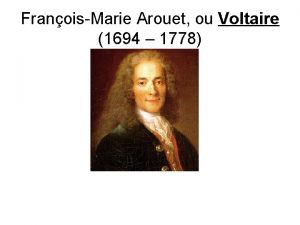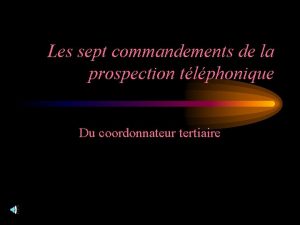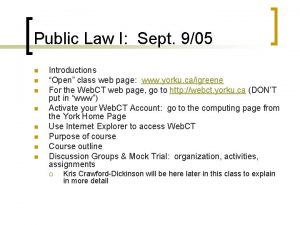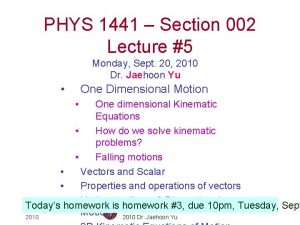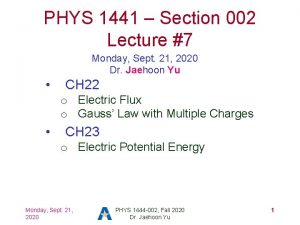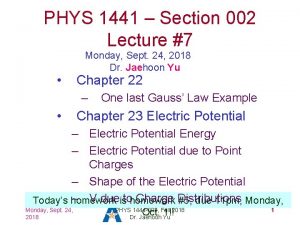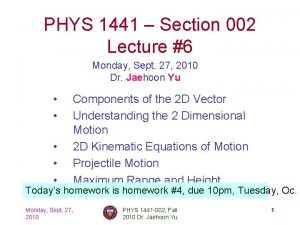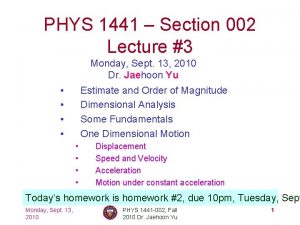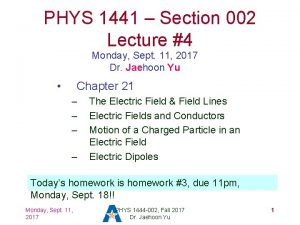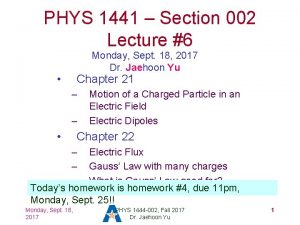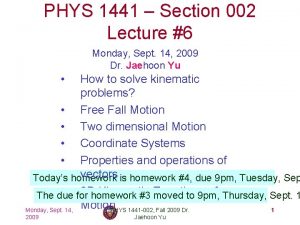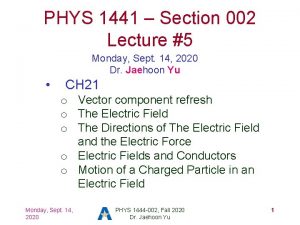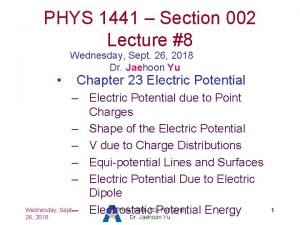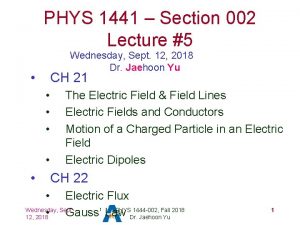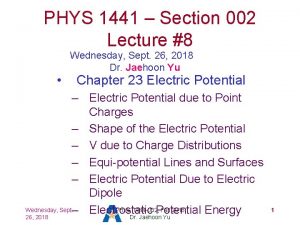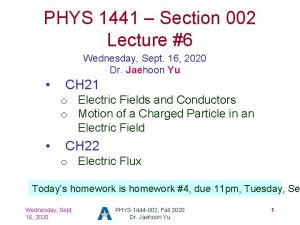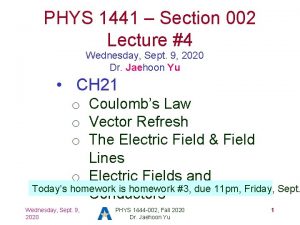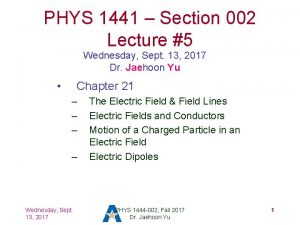PHYS 1441 Section 002 Lecture 7 Monday Sept



















- Slides: 19

PHYS 1441 – Section 002 Lecture #7 Monday, Sept. 25, 2017 Dr. Jaehoon Yu • Chapter 22 – • One last Gauss’ Law Example Chapter 23 Electric Potential – Electric Potential Energy – Electric Potential due to Point Charges – Shape of the Electric Potential Today’s homework is homework #5, due 11 pm, Monday, Oct. 2!! Monday, Sept. 25, 2017 PHYS 1444 -002, Fall 2017 Dr. Jaehoon Yu 1

Announcements • Reading assignments – CH 23. 9 • Bring out the special project #2 Monday, Sept. 25, 2017 PHYS 1444 -002, Fall 2017 Dr. Jaehoon Yu 2

Reminder: Special Project #3 • Particle Accelerator. A charged particle of mass M with charge -Q is accelerated in the uniform field E between two parallel charged plates whose separation is D as shown in the figure on the right. The charged particle is accelerated from an initial speed v 0 near the negative plate and passes through a tiny hole in the positive plate. – Derive the formula for the electric field E to accelerate the charged particle to a fraction f of the speed of light c. Express E in terms of M, Q, D, f, c and v 0. – (a) Using the Coulomb force and kinematic equations. (8 points) – (b) Using the work-kinetic energy theorem. ( 8 points) – (c) Using the formula above, evaluate the strength of the electric field E to accelerate an electron from 0. 1% of the speed of light to 90% of the speed of light. You need to look up the relevant constants, such as mass of the electron, charge of the electron and the speed of light. (5 points) • Due beginning of the class Monday, Oct. 2 Monday, Sept. 25, 2017 PHYS 1444 -002, Fall 2017 Dr. Jaehoon Yu 3

A Brain Teaser of Electric Flux • What would change the electric flux through a circle lying in the xz plane where the electric field is (10 N/C)j? 1. Changing the magnitude of the electric field 2. Changing the surface area of the circle 3. Tipping the circle so that it is lying in the xy plane 4. All of the above 5. None of the above Monday, Sept. 25, 2017 PHYS 1444 -002, Fall 2017 Dr. Jaehoon Yu 4

Gauss’ Law Summary • The precise relation between flux and the enclosed charge is given by Gauss’ Law • ε 0 is the permittivity of free space in the Coulomb’s law • A few important points on Gauss’ Law – Freedom to choose!! • The integral is performed over the value of E on a closed surface of our choice in any given situation. – Test of existence of electrical charge!! • The charge Qencl is the net charge enclosed by the arbitrary closed surface of our choice. – Universality of the law! • It does NOT matter where or how much charge is distributed inside the surface. – The charge outside the surface does not contribute to Qencl. Why? • The charge outside the surface might impact field lines but not total lines 1444 -002, entering leaving the surface Monday, the Sept. 25, number of PHYS Fallor 2017 5 2017 Dr. Jaehoon Yu

Example 22 – 6 Long uniform line of charge: A very long straight wire possesses a uniform positive charge per unit length, λ. Calculate the electric field at points near but outside the wire, from thethe ends. • Which direction dofar you think field due to the charge on the wire is? – Radially outward from the wire, the direction of radial vector r. • Due to cylindrical symmetry, the field is the same on the Gaussian surface of a cylinder surrounding the wire. – The end surfaces do not contribute to the flux at all. Why? • Because the field vector E is perpendicular to the surface vector d. A. • From Gauss’ law Solving for E Monday, Sept. 25, 2017 PHYS 1444 -002, Fall 2017 Dr. Jaehoon Yu 6

Electric Potential Energy • Concept of energy is very useful solving mechanical problems • Conservation of energy makes solving complex problems easier. • When can the potential energy be defined? – Only for a conservative force. – The work done by a conservative force is independent of the path. What does it only depend on? ? • The difference between the initial and final positions – Can you give me an example of a conservative force? • Gravitational force • Is the electrostatic force between two charges a conservative force? – Yes. Why? – The dependence of the force to the distance is identical to that of the gravitational force. • The only thing matters is the direct linear distance between the objects not the path. Monday, Sept. 25, PHYS 1444 -002, Fall 2017 7 2017 Dr. Jaehoon Yu

Electric Potential Energy • How would you define the change in electric potential energy Ub – Ua? – The potential gained by the charge as it moves from point a to point b. The consider negative work done on the charge by thetwo electric force to move • –Let’s an electric field between it from a to b. parallel plates w/ equal but opposite charges – The field between the plates is uniform since the gap is small and the plates are infinitely long… • What happens when we place a small charge, +q, on a point at the positive plate and let go? – The electric force will accelerate the charge toward negative plate. – What kind of energy does the charged particle Monday, Sept. 25, PHYS 1444 -002, Fall 2017 gain? 2017 • Kinetic energy Dr. Jaehoon Yu 8

Electric Potential Energy • What does this mean in terms of energies? – The electric force is a conservative force. – Thus, the mechanical energy (K+U) is conserved under this force. – The charged object has only the electric potential energy (no KE) at the positive plate. – The electric potential energy decreases and – Turns into kinetic energy as the electric force works on the charged object, and PE=U KE=0 the charged object gains speed. ME=U • Point potential energy for Monday, of Sept. greatest 25, PHYS 1444 -002, Fall 2017 Dr. Jaehoon Yu – Positively charged object 0 K K U+K 9

Electric Potential • How is the electric field defined? – Electric force per unit charge: F/q • We can define electric potential (potential) as – The electric potential energy per unit charge – This is like the voltage of a battery… • Electric potential is written with a symbol V – If a positive test charge q has potential energy Ua at a point a, the electric potential Monday, Sept. 25, PHYS 1444 -002, Fall 2017 10 of the charge at that point is 2017 Dr. Jaehoon Yu

Electric Potential • Since only the difference in potential energy is meaningful, only the potential difference between two points is measurable • What happens when the electric force does “positive work”? – The charge gains kinetic energy – Electric potential energy of the charge decreases • Thus the difference in potential energy is the same as the negative of the work, Wba, done on the charge by the electric field to move the charge from point a to b. • The potential difference Vba is Monday, Sept. 25, 2017 PHYS 1444 -002, Fall 2017 Dr. Jaehoon Yu 11

• A Few Things about Electric What does the electric potential depend on? Potential – Other charges that creates the field – What about the test charge? • No, the electric potential is independent of the test charge • Test charge gains potential energy by existing in the potential created by other charges • Which plate is at a higher potential? – Positive plate. Why? • Since positive charge has the greatest potential energy on it. – What happens to the positive charge if it is let go? • It moves from higher potential to lower potential – How about a negative charge? • • • Its potential energy is higher on the negative plate. Thus, it moves from negative plate to positive. Potential difference is the same. Zero point of electric The unit of the electric potential is Volt (V). potential can be chosen arbitrarily. From the definition, 1 V = 1 J/C. Often the ground, a Monday, Sept. 25, PHYS 1444 -002, Fall 2017 12 conductor connected to 2017 Dr. Jaehoon Yu Earth, is zero.

Example 23 – 1 A negative charge: Suppose a negative charge, such as an electron, is placed at point b in the figure. If the electron is free to move, will its electric potential energy increase or decrease? How will the electric potential change? • An electron placed at point b will move toward the positive plate since it was released at its highest potential energy point. • It will gain kinetic energy as it moves toward left, decreasing potentialmoves energy. from the point b at a • The electron, itshowever, lower potential to point a at a higher potential. ΔV=Va – Vb>0. • This is because the potential is generated by the Monday, Sept. 25, PHYS 1444 -002, Fall 2017 13 charges on the plates not by the electron. 2017 Dr. Jaehoon Yu

• Electric Potential and Potential Energy What is the definition of the electric potential? – The potential energy difference per unit charge • OK, then, how would you express the potential energy that a charge q would obtain when it is moved between point a and b with the potential difference Vba? – In other words, if an object with charge q moves through a potential difference Vba, its potential energy changes by q. Vba. • So based on this, how differently would you describe the electric potential in words? – A measure of how much energy an electric charge can Monday, Sept. 25, PHYS 1444 -002, Fall 2017 14 acquire in a given situation 2017 Dr. Jaehoon Yu

• Comparisons of Potential Energies Let’s compare gravitational and electric potential m energies 2 m • What are the potential energies of the rocks? charges? – mgh and 2 mgh – QVba and 2 QVba • Which rock has a bigger potential energy? • Which object has a bigger potential energy? – The rock with a larger mass – The object with a larger charge. • Why? Monday, Sept. 25, PHYS 1444 -002, Fall 2017 15 The 2017 potential is the same but the heavier rock or larger charge can do a g Dr. Jaehoon Yu – It’s got a bigger mass. – It’s got a bigger charge.

• Electric Potential and Potential Energy The electric potential difference gives potential energy or the possibility to perform work based on the charge of the object. • So what is happening in a battery or a generator? – They maintain a potential difference. – The actual amount of energy used or transformed depends on how much charge flows. – How much is the potential difference maintained by a car’s battery? • 12 Volts Joules – If for a given period, 5 C charge flows through the headlight lamp, what is the total energy transformed? • Etot=5 C*12 V=60 Umm… What is the unit? 1444 -002, Fall 2017 – If it is left on twice. PHYS as. Dr. long? E =10 C*12 V=120 J. tot Jaehoon Yu Monday, Sept. 25, 2017 16

Some Typical Voltages Sources Thundercloud to ground High-Voltage Power Lines Power supply for TV tube Automobile ignition Household outlet Automobile battery Flashlight battery Resting potential across nerve membrane Approximate Voltage 108 V 106 V 104 V 102 V 1. 5 V 10 -1 V In a typical lightening strike, 15 C of electrons are released in 500μs. Potential changes skinof(EKG -4 V strike What is the total kineticon energy these electrons when 10 they and EEG) ground? What is the power released during this strike? What do you Monday, Sept. 25, 2017 to a tree. PHYS 1444 -002, Fall 2017 17 think will happen hit by this lightening? Dr. Jaehoon Yu

Example 23 – 2 Electrons in TV tube: Suppose an electron in the picture tube of a television set is accelerated from rest through a potential difference Vba=+5000 V. (a) What is the change in potential energy of the electron? (b) What is the speed of the electron (m=9. 1 x 10 -31 kg) as a result of this acceleration? (c) Repeat for a proton (m=1. 67 x 10 -27 kg) that accelerates through a potential difference of Vba=5000 V. • (a) What is the charge of an electron? – • So what is the change of its potential energy? Monday, Sept. 25, 2017 PHYS 1444 -002, Fall 2017 Dr. Jaehoon Yu 18

Example 23 – 2 • (b) Speed of the electron? – The entire potential energy of the electron turns to its kinetic energy. Thus the equation is • (C) Speed of a proton? Monday, Sept. 25, 2017 PHYS 1444 -002, Fall 2017 Dr. Jaehoon Yu 19
 Jan van eyck (1390-1441)
Jan van eyck (1390-1441) Phys 241 lecture quizzes
Phys 241 lecture quizzes 01:640:244 lecture notes - lecture 15: plat, idah, farad
01:640:244 lecture notes - lecture 15: plat, idah, farad Trois quatre cinq
Trois quatre cinq Deportes
Deportes Candide ou l optimisme
Candide ou l optimisme How many hills is jerusalem built on
How many hills is jerusalem built on Poésie le dernier sapin mr truchi
Poésie le dernier sapin mr truchi Ecrivez les sept jours de la semaine
Ecrivez les sept jours de la semaine Sept commandements
Sept commandements Cnn 10 september 4
Cnn 10 september 4 Sept heure moins le quart
Sept heure moins le quart Damon poole
Damon poole Sept prefix words
Sept prefix words Sept
Sept I sept
I sept Sept comme setteur questionnaire
Sept comme setteur questionnaire C++ mfc 예제
C++ mfc 예제 Norsok z-dp-002
Norsok z-dp-002 Semt.002
Semt.002





